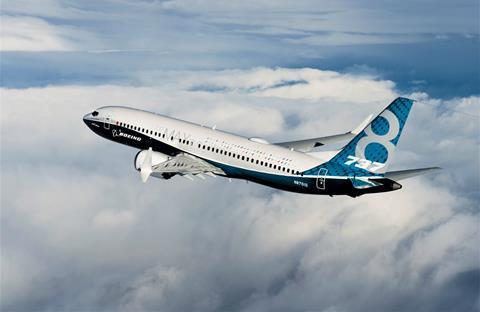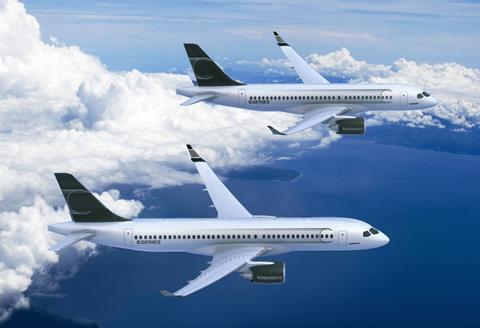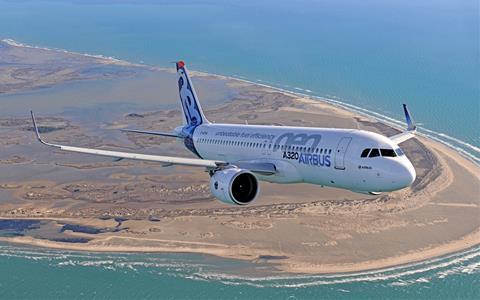Back in the 1950s, as the commercial aviation world began what would be a rapid transition from “props” to the Jet Age, the mainstream aircraft manufacturers faced the dilemma over how they should bridge the transition in engine technologies. The options were fairly simple - grab the bull by the horns with a higher-risk pure-jet design, or take the more cautious “propeller-turbine” (turboprop) route.
A decade ago the OEMs faced a similar dilemma when the arrival of new engine technology in the form of the Pratt & Whitney Geared Turbofan PW1000G series promised to shake up the industry.
While it offered re-engining opportunities for Airbus and Boeing, there was also the serious prospect that it could trigger the development of an all-new single-aisle. Bombardier certainly thought so, launching the CSeries in 2008 backed by orders from a blue-chip customer – Lufthansa.

History shows that back in the 1950s Douglas called it right with the DC-8 jetliner, as did Boeing with its 707 – which had far less to lose as it was very much a secondary player in the 1950s commercial aviation scene. The stakes were high for Lockheed. Its iconic Constellation “propliner” was the major rival to Douglas Commercial “DC” series – and Burbank effectively sealed its fate to ultimately exit the commercial sector by deciding against a jet and developing the USA’s only large turboprop – the L-188 Electra.
Fast forward to the late 2000s and the two single-aisle incumbents were pondering how to respond to the arrival of the GTF – and the CSeries. Both had much to lose if they called it wrong. Re-engining was lower risk of course, but the big prize could lie with the creation of an all-new aircraft. Ultimately they both adopted the derivative approach which has proved to be a smart commercial move for the last 10 years, with combined sales exceeding 12,000 aircraft.

However, the paths to those decisions were not straightforward – and for one of the protagonists, at least, its strategy appears to have come back to haunt it.
Airbus had been taking a close look at the GTF for several years and flight-tested the engine on its A340 development aircraft. It was the first to blink when it launched the re-engined A320neo in late 2010. Power came from the PW1000G along with the new “Leap-X” offering from CFM International.
This was a gamble designed primarily at preventing Bombardier from making deep inroads into the lower end of its market with the CSeries. It also meant that Airbus had rolled the dice, committing to the re-engining route and leaving the path open to its rival possibly launching a clean-sheet project.
Boeing looked very seriously at the high-stakes option – dubbed New Single Aisle (NSA) – with service entry slated for the early 2020s. And there was a lot going for the NSA option. For one, a third adaptation of the 737 airframe to accommodate a new engine was more troublesome than it had been for Airbus with the A320. Secondly, the 737’s core technology was arguably at least one generation – if not two – behind that of its European rival.

But Airbus’s leadership was fairly confident that Boeing would not be able to make the sums work for the launch of an all-new single-aisle in 2011. And all the time Seattle dithered, the A320neo hoovered up the orders.
“Our own internal modelling of an all-new aeroplane showed it was only going to bring another 3% of performance improvement over the A320neo’s 15%,” says former Airbus chief operating officer Tom Williams, who was executive vice-president programmes at the time of the A320neo launch. “And the unit costs looked horrendous because trying to build in high volume in carbonfibre is not easy and not cheap.”
Speaking to FlightGlobal for our Airbus at 50 supplement in April 2019, Williams said the decision to launch the A320neo – which he admitted was aimed at the CSeries rather than the 737 – was fairly straightforward in the end. Although he conceded the decision came after dispelling early concerns about the philosophy of grafting such large engines onto an existing design: “If we tinker with this product, at what point do we do something that becomes dysfunctional?” he said.
“So it was really an argument that said the all-new single-aisle really needs to wait until the next step of engine technology like contra-rotating open rotor, and that’s not going to come until the latter part of the next decade. So we should get on and do this re-engining.”
Boeing initially tried to ignore the noise coming out of Toulouse, keeping its sights firmly on the potentially larger long-term prize to be gained with a bold move into an all-new design - much like it had with the launch of the 787. But as the pressure built steadily in Seattle, Boeing began warming to a 737 derivative and just ahead of the 2011 Paris air show it presented a chart claiming that a re-engined “737-800RE” would have 8% lower cash operating costs than the A320neo.
There was pressure building from inside Boeing too, as it continued working to get the delayed 787 development back on track while also needing a succession plan for the 777. With its hands already full, there was arguably insufficient bandwidth to develop another all-new airliner.
Customers were adding to Boeing’s dilemma. One key 737 client – American Airlines – was looking set to buy big in Toulouse while another – Herb Kelleher, co-founder of all-737 operator Southwest Airlines – urged Boeing to get on with the NSA and be more aggressive with the schedule to ensure service entry before the end of the decade.
The month after June’s Paris air show Jim Albaugh, the then chief executive of Boeing Commercial Airplanes, gave the green light to a major derivative of the 737 re-engined with the CFM Leap. The strategy stopped American walking away entirely – the Dallas/Fort Worth carrier split its order between the A320neo and the 737RE. And significantly Southwest then signed a major deal for the new 737 at the end of 2011.
So Boeing defied the sceptics who thought the 737 had reached the end of the road, choosing a derivative over clean-sheet for its next assault on the single-aisle sector. Its successor to the best-selling 737NG would be dubbed “737 Max”.
“I continue to believe that [launching] the Max was the right decision at the time. The enabling technologies simply weren’t there to justify the non-recurring costs of a clean-sheet, and customers just wanted new engines,” says Richard Aboulafia, vice-president of analysis at Teal Group.

Analysts at consultancy Ascend by Cirium concur that based on what Boeing knew at the time, a derivative approach was the right decision.
“If Boeing had not launched the Max, Airbus would have had a short-term benefit in market share, as Boeing would have had an uncompetitive product for several years,” says Richard Evans, senior consultant at Ascend by Cirium. “Boeing was definitely concerned about the ability to ramp up an all-new product, a concern that will still apply to any new single-aisle in the future.”
Rob Morris, who is global head of consultancy at Ascend, believes that Boeing “was left with no option” but to launch a derivative aircraft.
“Given the competitive dynamic in 2011…technology readiness would not have allowed Boeing to bring an ‘NSA’ to market sufficiently quickly to block A320neo sales,” he says. “And airlines would have perceived such risk and uncertainty in NSA that it is unlikely they would have been willing to wait.”
Aboulafia believes Boeing spent the appropriate amount of time developing the 737 Max, but it still wasn’t enough to eliminate a fatal flaw: “It was not a rushed job; six years is a lavish amount of time to allow for a derivative jetliner. The result is a good jet, but one with a problem,” he says.
“The Max wasn’t flawed, but the design and integration of the MCAS [Maneuvering Characteristics Augmentation System] certainly was. But the two aren’t the same. The Max doesn’t need MCAS, and even if it would be useful for the Max, the three primary fixes envisaged for MCAS are more than enough to make it safe. The only question, of course, is how Boeing got to that point,” says Aboulafia.
“I am sure the 737 Max design was credible, but for sure execution has caused Boeing to be where it is today,” says Morris.
He adds that while he is confident that Boeing will get on top of the Max issues and the aircraft will become a credible programme, Morris does not expect it to ever be a fully viable rival to the A320neo family: “Boeing will not be able to achieve 50% market share versus A320neo family because the A321neo is fundamentally a better aircraft than 737 Max 9/10.”
Perhaps that factor alone – with benefit of hindsight – will be the most significant repercussion of Boeing’s decision to stick with the 737 a decade ago?
“Of course, since then, the upgauging trend at airlines has greatly increased, which makes a new larger single-aisle more appealing,” says Aboulafia. “But that certainly wasn’t known at the time. And even now, I still think that might need to be a different plane than a family based on a 150-seater anyway.”


























